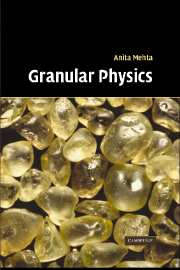Book contents
- Frontmatter
- Contents
- Preface
- 1 Introduction
- 2 Computer simulation approaches – an overview
- 3 Structure of vibrated powders – numerical results
- 4 Collective structures in sand – the phenomenon of bridging
- 5 On angles of repose: bistability and collapse
- 6 Compaction of disordered grains in the jamming limit: sand on random graphs
- 7 Shaking a box of sand I – a simple lattice model
- 8 Shaking a box of sand II – at the jamming limit, when shape matters!
- 9 Avalanches with reorganising grains
- 10 From earthquakes to sandpiles – stick–slip motion
- 11 Coupled continuum equations: the dynamics of sandpile surfaces
- 12 Theory of rapid granular flows
- 13 The thermodynamics of granular materials
- 14 Static properties of granular materials
- References
- Index
- Plate section
4 - Collective structures in sand – the phenomenon of bridging
Published online by Cambridge University Press: 06 October 2009
- Frontmatter
- Contents
- Preface
- 1 Introduction
- 2 Computer simulation approaches – an overview
- 3 Structure of vibrated powders – numerical results
- 4 Collective structures in sand – the phenomenon of bridging
- 5 On angles of repose: bistability and collapse
- 6 Compaction of disordered grains in the jamming limit: sand on random graphs
- 7 Shaking a box of sand I – a simple lattice model
- 8 Shaking a box of sand II – at the jamming limit, when shape matters!
- 9 Avalanches with reorganising grains
- 10 From earthquakes to sandpiles – stick–slip motion
- 11 Coupled continuum equations: the dynamics of sandpile surfaces
- 12 Theory of rapid granular flows
- 13 The thermodynamics of granular materials
- 14 Static properties of granular materials
- References
- Index
- Plate section
Summary
Introduction
From a general introduction to phenomena in vibrated sand, we focus now on (granular) matter in the jammed state, which has become a focus of interest for physicists in recent years. Glasses manifest jamming, in addition to densely packed granular media; while the mechanisms of jamming in each case show strong similarities, the ineffectiveness of temperature as a dynamical motor in granular media leads to vastly more surprising effects.
A direct consequence of such athermal behaviour in sandpiles is the stable formation of cooperative structures such as bridges, or indeed the very existence of an angle of repose; neither would be possible in the presence of Brownian motion. In this chapter and the next, we show that the dynamics of bridge formation is a typical result of collective dynamics, as is the relaxation of the angle of repose; competition between density fluctuations and external driving forces can, on the other hand, result in sandpile collapse. The chapters which follow these, with their focus on jamming, unify aspects of glasses and granular media; one of them uses random graphs to illustrate competitive and cooperative effects in granular compaction, while the other makes clear how asymmetric grains can orient themselves suitably so as to waste less space, as the jamming limit is approached.
- Type
- Chapter
- Information
- Granular Physics , pp. 52 - 62Publisher: Cambridge University PressPrint publication year: 2007



